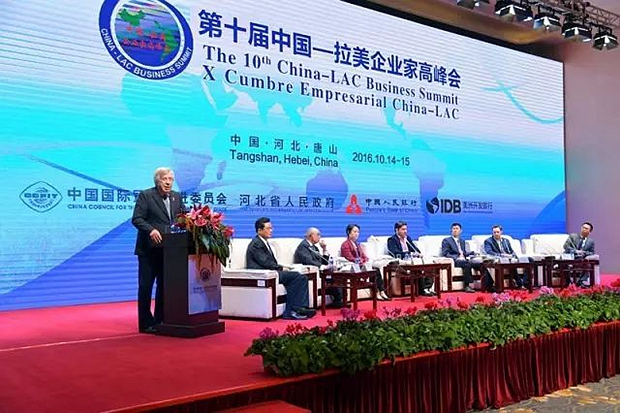China to extend the BRI into Latin America
- By Sabena Siddiqui
 0 Comment(s)
0 Comment(s) Print
Print E-mail China.org.cn, March 15, 2018
E-mail China.org.cn, March 15, 2018

The 10th China-LAC Business Summit is held in Tangshan, China's Hebei province, Oct. 14-15, 2016. [Photo/Xinhua]
With 33 member states, the Community of Latin American and Caribbean States (CELAC) is South America's largest regional bloc. During the great recession of 2008 this region faced huge difficulties in securing international financing from lending institutions such as the IMF and World Bank, leading many countries to turn to China, who is now the largest trade partner for some, including Chile, Brazil and Argentina.
It is fascinating to note that trade between China and Latin America was virtually non-existent at the turn of this century but rocketed to a remarkable $200 billion per year by 2014. Having already registered a record 2,000 percent increase since the year 2000, the extent of trade is set to grow exponentially as further diversification in Chinese investments is expected in the future. According to ongoing plans, China is directing $250 billion to the region in direct investments, in addition to about $500 billion in trade, between 2015 and 2019.
Trade is poised to expand further as economic engagement is spurred in six key sectors, namely manufacturing, information technology, scientific innovation, infrastructure, agriculture and natural energy resources. Chile is doing extremely well exporting wine, fruit and modified foods, while Colombian coffee is in huge demand abroad.
Increasing at the rate of 30 percent in 2017 alone, China is the largest trading partner of Peru, Chile and soon also Brazil. Investments from China having extended beyond raw-material extraction into car manufacturing, tech, and telecom, primarily in Venezuela, Brazil and Argentina. What's more, since the 2018 China-Chile free trade agreement, 98 percent of products traded between these two nations will have zero tariffs.
Now, in a recent watershed moment, China proposed to extend the Belt and Road Initiative (BRI) to the South American continent. At the second China-CELAC ministerial meeting, Chinese Foreign Minister Wang Yi urged the group of states to play a "meaningful role" in the New Silk Road and to support free trade as part of an "open world economy."
Three documents were penned at the meeting: the Santiago Declaration regarding climate change; a broad-based joint action plan addressing science and technology, infrastructure and renewable energy; and a special declaration on the Belt and Road Initiative. Emphasizing the need for land and sea connectivity projects, Wang Yi stressed, "It has nothing to do with geopolitical competition. It follows the principle of achieving shared growth through discussion and collaboration."
Extending the BRI to South America would greatly improve the region's connectivity, with projects such as the recommended 19,000-km trans-Pacific fiber optic internet line, which would run from China to Chile, shortening distances by linking people across the world.
Welcoming the multi-dimensional agreements, Professor Luis Suarez from Higher Institute of International Relations in Havana hopes that they will "change the traditional perception of Latin America as an exporter of commodities and lead to the exchange of products with greater added value from both directions."
Promoting globalization, free trade and cooperation in South America, China discourages trade protectionism and has expressed belief in the shared gains for all.
Having already invested in Latin American infrastructure, China now moves to increase connectivity by extending the BRI into the South American continent. Increasing the worth and utility of ongoing construction projects, the move would also benefit more than 2,000 Chinese business enterprises already engaged in Latin America with bilateral trade exceeding $210 billion in 2017.
Endorsing the idea, Wu Hongying from the China Institute of Contemporary International Relations stated, "The region is an integral part of joint efforts to develop the Belt and Road Initiative."
As Latin American countries, especially G20 members Brazil, Argentina and Mexico, sought out foreign investment to complete large-scale infrastructure construction, China stepped in to fill the gap. This in turn helped to improve the investment climate in the region, attracting more participation from foreign businesses.
In just 15 years, in fact, Chinese trade and investment has set off an economic boom in Latin America, doubling the size of its middle class and alleviating poverty significantly.
With a focusing on sustainability instead of profits, China has managed to withstand the unstable economic and political trends in Latin America over the years. As a result, some Latin American countries are now curious about how the Chinese economic model has managed to be more resistant to the global slowdown experienced to a greater degree in the U.S. and many other capitalist countries.
The future may bring further opportunities for China to collaborate with CELAC countries to facilitate social progress and economic growth.
Sabena Siddiqui (Twitter: @sabena_siddiqi) is a foreign affairs journalist and lawyer based in Pakistan.
Opinion articles reflect the views of their authors, not necessarily those of China.org.cn.






Go to Forum >>0 Comment(s)